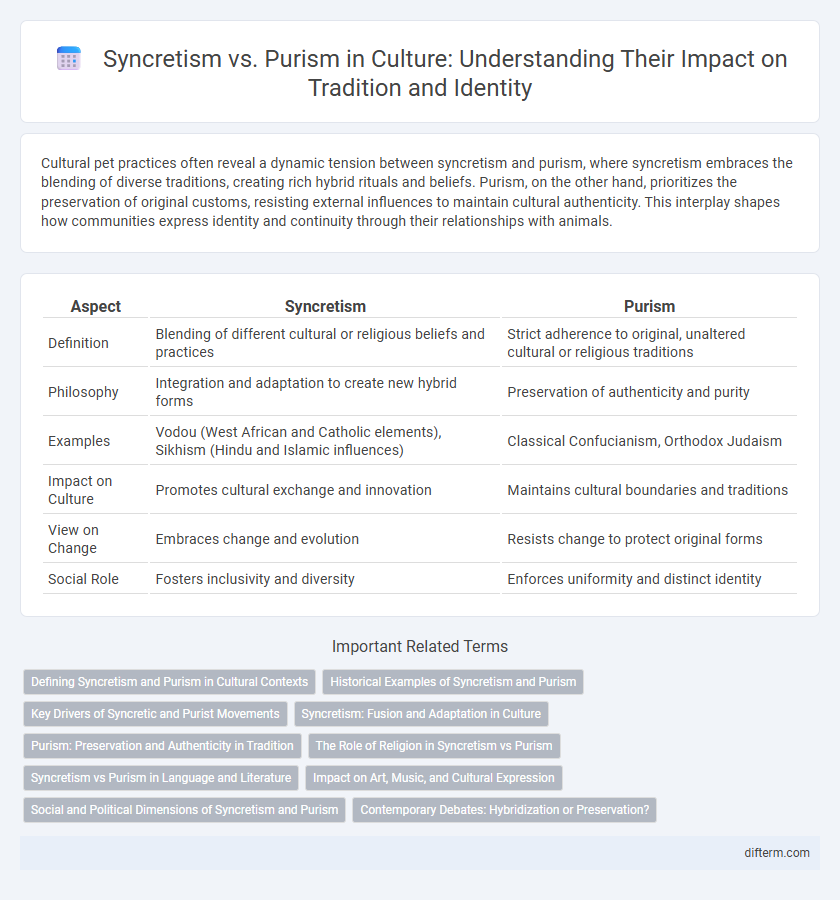Cultural pet practices often reveal a dynamic tension between syncretism and purism, where syncretism embraces the blending of diverse traditions, creating rich hybrid rituals and beliefs. Purism, on the other hand, prioritizes the preservation of original customs, resisting external influences to maintain cultural authenticity. This interplay shapes how communities express identity and continuity through their relationships with animals.
Table of Comparison
| Aspect | Syncretism | Purism |
|---|---|---|
| Definition | Blending of different cultural or religious beliefs and practices | Strict adherence to original, unaltered cultural or religious traditions |
| Philosophy | Integration and adaptation to create new hybrid forms | Preservation of authenticity and purity |
| Examples | Vodou (West African and Catholic elements), Sikhism (Hindu and Islamic influences) | Classical Confucianism, Orthodox Judaism |
| Impact on Culture | Promotes cultural exchange and innovation | Maintains cultural boundaries and traditions |
| View on Change | Embraces change and evolution | Resists change to protect original forms |
| Social Role | Fosters inclusivity and diversity | Enforces uniformity and distinct identity |
Defining Syncretism and Purism in Cultural Contexts
Syncretism in cultural contexts refers to the blending of diverse religious, philosophical, or cultural traditions into a cohesive new system, often resulting in innovative expressions and hybrid identities. Purism, by contrast, emphasizes maintaining the original, unaltered form of a tradition, resisting influences perceived as external or corrupting to preserve authenticity. Understanding the tension between syncretism and purism reveals how cultures negotiate identity, continuity, and change amidst globalization and cultural exchange.
Historical Examples of Syncretism and Purism
Historical examples of syncretism include the blending of Greco-Roman and Egyptian religious practices during the Hellenistic period, exemplified by the cult of Serapis. In contrast, purism is evident in the Protestant Reformation, which sought to restore Christianity to its original doctrines by rejecting Catholic rituals and traditions perceived as corrupt. These cases illustrate how syncretism fosters cultural and religious integration, while purism emphasizes preservation and return to perceived authentic origins.
Key Drivers of Syncretic and Purist Movements
Syncretic movements are primarily driven by cultural exchange, globalization, and the need to reconcile diverse belief systems, fostering innovation and adaptation within societies. Purist movements emphasize identity preservation, reacting to perceived threats from external influences by advocating for tradition, authenticity, and cultural homogeneity. Both dynamics shape social cohesion and conflict, influencing how communities negotiate change and continuity in multicultural contexts.
Syncretism: Fusion and Adaptation in Culture
Syncretism embodies the dynamic fusion and adaptation of cultural beliefs, practices, and traditions, resulting in hybrid systems that reflect diverse influences and innovation. This process fosters cultural resilience and creativity by blending elements from different origins into cohesive new forms, evident in religious rituals, languages, and artistic expressions worldwide. Syncretic cultures emphasize integration and transformation, promoting inclusivity and ongoing evolution within global cultural landscapes.
Purism: Preservation and Authenticity in Tradition
Purism emphasizes the preservation of cultural heritage by maintaining the authenticity of traditional practices, rituals, and values without external influence or modification. It advocates for safeguarding cultural identity through strict adherence to original customs, resisting syncretic blending that could dilute core meanings. This approach is crucial for communities aiming to protect their historical narratives and cultural integrity against globalization and hybridization pressures.
The Role of Religion in Syncretism vs Purism
Religion serves as a pivotal force in syncretism by blending diverse beliefs and rituals to form cohesive cultural identities, often easing social integration. In contrast, purism in religion emphasizes preserving original doctrines and practices, rejecting external influences to maintain spiritual authenticity and continuity. The tension between syncretism and purism shapes cultural evolution, influencing how communities adapt or resist religious change.
Syncretism vs Purism in Language and Literature
Syncretism in language and literature involves blending elements from diverse linguistic and cultural traditions to create hybrid expressions and narratives, enriching the communicative repertoire and fostering cross-cultural understanding. Purism, by contrast, emphasizes the preservation of linguistic and literary forms in their original, unaltered states, focusing on maintaining historical authenticity and resisting external influences to safeguard cultural identity. The tension between syncretism and purism shapes how languages evolve, influencing literary canons, language policies, and cultural dialogues worldwide.
Impact on Art, Music, and Cultural Expression
Syncretism in art and music fosters rich, innovative cultural expressions by blending diverse traditions and styles, creating dynamic and multifaceted works that resonate across communities. Purism, by contrast, emphasizes the preservation of original forms and techniques, often safeguarding cultural heritage but potentially limiting creative evolution and cross-cultural dialogue. The tension between syncretism and purism shapes the ongoing development of cultural identity through artistic mediums, influencing how societies interpret and value their cultural legacies.
Social and Political Dimensions of Syncretism and Purism
Syncretism fosters social cohesion by blending diverse cultural and religious beliefs, promoting inclusivity within pluralistic societies. Purism, often rooted in political ideologies, emphasizes preserving cultural or religious "authenticity," sometimes leading to exclusion or conflict with minority groups. The political dimensions of both approaches affect identity formation, social policies, and power dynamics in multicultural nations.
Contemporary Debates: Hybridization or Preservation?
Contemporary debates in culture revolve around syncretism's hybridization, blending diverse traditions to create dynamic, evolving identities versus purism's focus on preserving authentic, unaltered cultural heritage to maintain historical continuity. Scholars argue syncretism fosters innovation and inclusivity, while purism safeguards against cultural dilution and loss of heritage. These contested perspectives shape policies on cultural expression, education, and heritage conservation worldwide.
syncretism vs purism Infographic

 difterm.com
difterm.com